Indiana's Pioneer Heritage and the End of the Twentieth Century
Originally published in
Indiana History Bulletin Volume 67, Number 2
June 1996
Indiana's Pioneer Heritage and the End of the Twentieth Century
James H. Madison
Department of History, Indiana University Bloomington
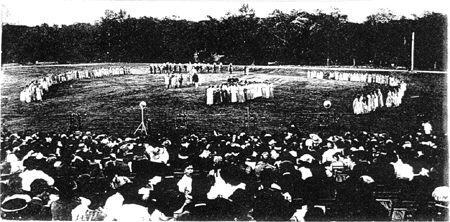
Indianapolis pageant, October 1916, for the centennial of statehood, December 11, 1916.
Indiana Division, Indiana State Library.
Every December 11 Hoosiers celebrate their state's birthday. As with all birthdays and anniversaries, we reminisce and honor and glorify, as we look backward in hopes of seeing where we have been and where we are going.
Indiana Counties at Statehood
December 11, 1816
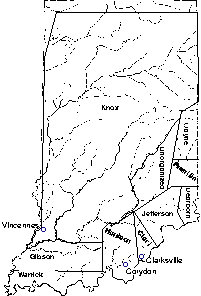
George Pence and Nellie C. Armstrong, Indiana Boundaries
(Indianapolis: Indiana Historical Bureau, 1933; reprint, 1967), 147, 533.
The state's birthday is a wonderful occasion to think about Indiana's beginnings and about those people who created Indiana, those we revere as pioneers. Going a step further, we can think even about the connections between their lives and ours. Where are we in relation to them as the twentieth century comes to an end? Can pioneers help us live hopefully when there is so much pessimism around us? Can pioneers help us find optimism when so much seems ambiguous and complex?
A good starting point for such thinking is the Constitution of 1816. This document is the state's birth certificate. It is the founding statement in the masterful form of the pioneer generation's hope for their new-born state.
The original document itself has rightly become an icon, an object of secular-religious status, like the thigh bone of a saint. We can be grateful that the Indiana State Archives exists to preserve the original copies of the Constitution, and we can hope that every December 11, Hoosiers will have a chance to look at the original.
It's the content, however, not the paper object that makes the Constitution of 1816 important. In fact, it's my favorite document in all of Indiana history. I assign it in my Indiana history class at Indiana University--all of it and spend an entire class period discussing it with students. It is not only that this is our founding document. More importantly, we can read the Constitution as a window into what pioneers thought about themselves and about their future. For those wanting to celebrate and honor pioneer achievement, here is their greatest monument.
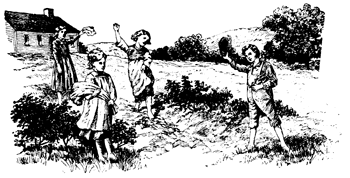
The Indiana Constitution of 1816 was written in typically hot summer in the southern Indiana town of Corydon, then the territorial capital and soon the first state capital. Forty-three men labored over the writing. A few highlights will give a sense of their magnificent vision.
The 1816 Constitution begins with a bill of rights, more optimistic and radical than the federal bill of rights. For example:
- ". . . all men are born equally free and independent . . . ."
- ". . . all power is inherent in the people . . . ."
- ". . . The free communication of thoughts, and opinions, is one of the invaluable rights of man; and every citizen may freely speak, write, and print on any subject . . . ."
These bold guarantees of liberty and this confidence and trust placed in the fundamental wisdom of ordinary Hoosiers constitute a central achievement and a great gift from our pioneer generation. If there ever was frontier democracy, here it is.
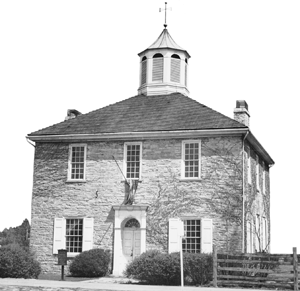
State House, Corydon, Indiana.
Indiana Division, Indiana State Library.
Beyond this bill of rights, there are all sorts of other appealing features. The Constitution of 1816 outlawed slavery. It promised a penal code "founded on principles of reformation and not of vindictive justice." And most impressive to many today it offered hope for "a general system of education, ascending in regular gradation, from township schools to a state university, wherein tuition shall be gratis, and equally open to all."
What a bright blueprint for the future of pioneer Indiana and for all Hoosiers. Did Hoosier pioneers live up to this high ideal, to its grand commitments and lofty promises? Of course not. It's naive to think that any people could.
The place of the Constitution of 1816 in the lives of pioneer Hoosiers is far more ambiguous than the actual language of the document and more ambiguous too than our celebrations of it might suggest.
Pioneers failed miserably to create a system of free public education all the way to a state university, equal for all. Indeed, one ambiguous, even unhappy story here is that Indiana had a rate of adult illiteracy, as reported in the 1840 census, higher than that of any northern state. The pioneers did not deliver fully on the education promise of 1816. Nor have we at the end of the twentieth century, from rising tuition at the state universities to school textbook fees to wide differences in our public schools.
Did the pioneers live up to the commitment to equality? Of course not. The most obvious example is contained in the lives of African-American Hoosiers. Our histories and our pioneer myths often feature stories of heroic exploits connected with the so-called underground railroad but ignore more important features of everyday life. In no sense was their equality for African-American Hoosiers. In many ways, in fact, there was less equality as time passed, with the black codes of the 1830s, with Article XIII of the 1851 Indiana Constitution (which stated that black newcomers could not reside within the borders of the state), with a segregated school system, and on and on.
Nor was there equality for pioneer women. They could not vote. Their legal rights were subsumed under those of their husband. As important, the celebrations and honors later generations have bestowed on our pioneers tended to celebrate the male accomplishment and to take for granted female achievement. (We can be especially thankful for the clear and wonderful fact of pioneer women's quilts--enduring artifacts that quickly remind us of female achievement.)
The Constitution of 1816, then, is a hope for the future rather than a description of early nineteenth-century Indiana. It promised far more than Hoosier pioneers could deliver.
There are other gaps between the claims made for heroic and wise pioneers and the realities of their lives. These are the stories and myths that grew and spread after the pioneer era had passed. At the center of these stories were tales of heroic achievement, of hardy pioneers building a civilization in the wilderness with the sweat of their brows and the muscle of their backs. Such stories were possible only when listeners allowed a romantic haze to obscure the reality of pioneer Indiana.
The powerful pioneer myths began with the memories of old pioneers themselves. Sitting around a comfortable iron stove in their front parlor, looking back on their early years, they did what humans in middle age and old age often do. They celebrated their youthful achievements. And perhaps they stretched the truth a bit so that it was uphill to school in both directions. And perhaps they forgot or didn't bother to speak about less heroic parts of their lives. By the 1850s and 1860s newspaper, accounts appeared telling of pioneer reunions and old settlers' meetings and of the stories told. Time had already woven a romantic haze over the pioneer story.
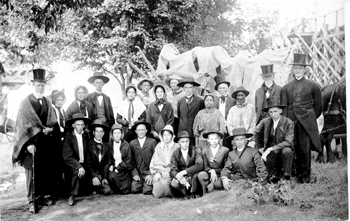
Parke County residents portray pioneers at their celebration for the centennial of statehood, December 11, 1916.
These romantic and selective memories of pioneering became by the end of the nineteenth century the Hoosier gospel. The heroic stories became the canon in local history books and pamphlets, in monuments, memorials, and patriotic speeches, and especially in the state centennial celebrations of 1916. At the end of the twentieth century, the stories and images still endure. They tower over us to insist that we look up in awe and respect for the courage, hard work, and sacrifice of the pioneers.
One example of the Hoosier pioneer gospel will suffice. John F. Haines in his History of Hamilton County published in 1915 opened his third chapter, on pioneers, in this way: The pioneers of Hamilton county were a race of brave and hardy men and women who came to establish homes in the almost impenetrable forest and conquer a wilderness, known to be infested with Indians, wild beasts and malignant fevers. Probably none of them dreamed how great would become the commonwealth which they were planting, nor how valuable within a century would become the land which they cleared and tilled, nor how wonderful the institutions which they established. How churches, schools and homes, cities and villages should spring up where once roamed the savage Indian, the timid deer, and the fierce wolf. How much greater they built than they knew.
This telling of the pioneer story is similar to many others across Indiana. Such stories have a powerful advantage of being very simple and very clear. They present a comforting, reassuring history, the kind of history many of us want to hear and want to teach students. And so our pioneers become good and wonderful and great. They become heroic forebears, indeed superheroes.
I want to suggest ambiguity and with it a bit more complexity, a bit more of the actual human qualities of pioneers. It's not only, as suggested in looking at the Constitution of 1816, that pioneers did not live up to the ideals they set for themselves. They cannot possibly bear the grand claims later generations have made for them. And these romantic stories of later generations raise important questions not only about our history but also about how we view our own lives and our futures as the twentieth century comes to an end.
Let me illustrate that point by suggesting some features not present in the traditional stories we tell about pioneers.
There developed in Indiana by the late nineteenth century a strong tendency to ignore the role of government. Many Hoosiers professed to believe that pioneers built their civilization in the wilderness by the sweat of their brows and the muscle of their backs--on their own. They didn't need government handouts or government bureaucrats telling them what to do.
Pioneer history is far more ambiguous than that. In fact, the government was a huge presence in Indiana long before Franklin D. Roosevelt's New Deal or Lyndon Johnson's Great Society. Federal, state and local government provided all manner of services, services not forced on resisting pioneers but demanded by them. Two examples at the center of the pioneer story can make the case.
First, it was the government, especially the federal government, that removed the Indians with military force, annuity payments, and treaties, so that pioneers could own and farm the land.
Second, it was the government that gave white settlers that public land at dirt cheap prices, land prices that declined as the years went by, and as pioneers hollered for cheaper and cheaper land. This public land giveaway program is one of the largest forms of federal aid in American history. It's a massive government handout, though we don't usually label it that. Most of us think the government's land policy was a good thing, but we seldom acknowledge its social welfare qualities.
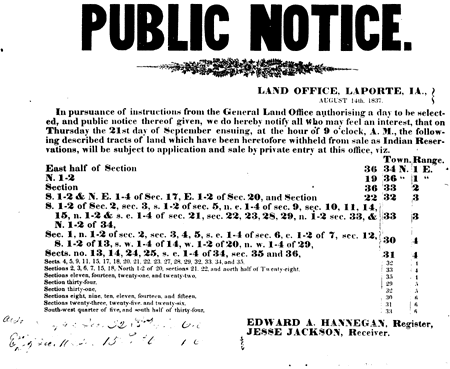
Indiana Division, Indiana State Library.
So, when our celebration of pioneers emphasizes their hardy independence, it ignores the manner in which they demanded, depended on, and prospered from government aid.
Another kind of ambiguity should temper our romantic myths of pioneers. Our pioneer stories celebrate their successes, collectively and individually, and ignore failure. What we know of ourselves was equally true of pioneers; some failed, at least some of the time.
A few pioneers succeeded magnificently. William Conner built a grand brick house on the prairie overlooking White River in 1823. (Conner made much of his money, by the way, from federal government service, as a kind of pioneer defense contractor.)
But for every Conner, there were other pioneers whose lives were not successful, certainly not in a material sense. A good example is the Lincoln family. The Lincolns left Indiana in 1830 when Abe was 21, worse off than when they arrived in 1816. This was not a frontier of success for Thomas Lincoln, and his son never forgot that fact.
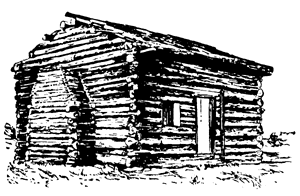
What may be the fundamental ambiguity and challenge for us in understanding pioneers is our difficulty in seeing them as flesh and blood human beings. One example may be extreme for some, but it is entirely valid and particularly revealing. It is sex.
I know of no scholarly study of pioneer Hoosier sexuality, and so I can't cite chapter and verse. But I know that the most energetic and active pioneers were in their teens, 20s, and 30s because it was younger settlers who moved to Indiana. I know that pioneers produced nothing in more abundance than they did pioneer babies. In fact, Indiana in the 1820s had a fertility rate as high as any place in the world.
Can we think about pioneers without thinking about love, marriage, and sex? And shouldn't we think also about gender roles, about the range of relationships between male and female, about the social and cultural roles assigned to and sometimes resisted by men and by women?
This leads to my primary point--a very simple point too often lost in our celebrations of pioneers. Pioneer Hoosiers were ordinary people. They had an abundance of ordinary common sense. Few, I suspect, were brilliant or self-sacrificing, or heroic, at least no more so in number or quality than in our own generation. This is NOT to argue that pioneers did not work hard, did not sweat, did not suffer. Many were courageous and hardy. Many were virtuous and noble. But I doubt they worked harder than we do. I doubt they were more courageous or hardy, more virtuous or noble.
Too often we look at pioneers as superheroes and compare them to our own generation in a way that does a disservice to our own achievement. It is true that few of us could move to Brown County with an ax, chop down a few poplar trees, and build a log cabin. No chain saw, no nails, no hardware store nearby. Few of us could survive a winter in such a cabin, with no furnace, no grocery store, no video rental.
Few of us could navigate a crude flatboat down the Wabash, Ohio, and Mississippi Rivers to New Orleans, as Abe Lincoln did at the age of 19, as hundreds of Hoosier pioneers did, and then return home from New Orleans by walking. Few of us could rear children or make a quilt with materials and conditions that prevailed in 1825.
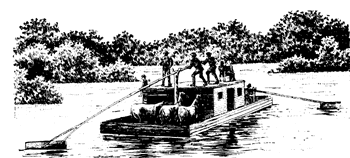
But then how many pioneers knew how to work a computer, how to find their way around a shopping mall, how to manage a two-career family.
We need to understand pioneers as ordinary people behaving in ordinary ways for their time and place, not heroic conquerors of wilderness and builders of civilization. They were not extra-humans with uncommon virtue of courage or brilliance. They were not superheroes.
Their most human qualities come through in one of the driving ambitions of pioneers. They did not want to be pioneers. They wanted to become something else, to move beyond that stage. They wanted to live in frame houses, not drafty and damp log cabins. They wanted an iron cook stove, not a fireplace. They wanted store-bought nails, coffee, sugar, cloth, and on and on.
To be a successful pioneer was to be on the way toward something else, as quickly as possible. In this, they were ordinary people.
To celebrate them as heroic demigods does a disservice to their humanity. And it places an impossible burden on us to live up to their imaginary achievements and mythic greatness. And thereby it sets us up for disillusionment and distrust, for cynicism and whining about our own times.
If we can see pioneers succeeding and failing and if we can understand the ambiguity and complexity of their lives, then we do justice to them and to ourselves and perhaps to the generations to come which will write the history of our times. Here is my final point. If I am right that these were ordinary people if I'm right that their lives were filled with ambiguity if I'm right that we go wrong when we celebrate them as superheroes, then is there nothing we can learn from pioneers? Is there no pioneer legacy?
I think there is. First, I think we learn from pioneer Hoosiers the wisdom of nurturing a common sense appropriate to time and place. Second, we learn to respect the difference between their time and ours, without denigrating their time or our time. A one-room log cabin made sense in 1830; a computer makes sense in 1996.
More important, I think we can learn optimism from pioneers. Sure there were pessimists among them. But the generation that pioneered in Indiana was above all optimistic: optimistic that things could be better and that they could collectively help things get better.
The best example of that generalization is the Internal Improvements Act of 1836. It is the most daring and optimistic piece of legislation ever passed by the Indiana General Assembly.
The legislature in 1836 authorized three major canal projects, the Central Canal, Whitewater, and Wabash & Erie extension. There was to be a macadamized road from New Albany to Vincennes. And most exciting, a railroad, running from Madison on Ohio to Indianapolis to Lafayette. To finance this grand public works project Indiana borrowed ten million dollars at five percent interest, this at a time when state revenue was about $120,000 a year.
Hoosier pioneers eagerly looked forward to a transportation network that would connect them to the outside world. Farmers, merchants, and travelers would move from cabins and villages to the market places of the nation and even the world.
The legislature authorized this mammoth system in spite of pioneers' professions of preference for small government, no taxes, independence, and self-sufficiency. And they did so because they believed so strongly in the future.
Now we know they failed. In the short run, at least, the system of 1836 went bankrupt and created a large embarrassment for Indiana. The pioneer generation often failed. But optimists know failure. And despite failure, this pioneer generation flourished on a strong base of optimism.
It is the spark and spunk of this generation that excites me, not their superhuman heroism. Despite a keen sense of limits they planned for change and believed in progress. Despite evidence that much could go wrong, they hoped much more would go right. That way of thinking is their legacy for us.
Some might be thinking that was then. The times are different in the 1990s. We know real limits, we understand failure, we seek shelter. We can't do it all. We must cut, not build.
Perhaps. But I would suggest a different legacy--one of optimism, one that celebrates Indiana's best traditions, from the Constitution of 1816 to our own time, not a mindless or heroic celebration, but one more ambiguous, one that gives a real base on which to build rather than romantic myths and legends. Our pioneer legacy comes from people far more ambiguous and far more interesting than those heroic myths.
So, as the twentieth century moves to an end, I'll look back to the Constitution of 1816 and to the Hoosier pioneers and hope for the future of Indiana into the twenty-first century.
Dr. Madison based this paper on his talk at the Indiana Statehood Day celebration co-sponsored by the Indiana Historical Bureau and the Indiana Historical Society, December 10, 1995, Indiana Government Center, Indianapolis.
The Indiana Historical Bureau disclaims responsibility for statements, whether of fact or opinion, made by contributors.
Illustrative engravings not otherwise credited are reproduced from Florence Bass, Stories of Pioneer Life (Boston: D. C. Heath & Co., 1890).
